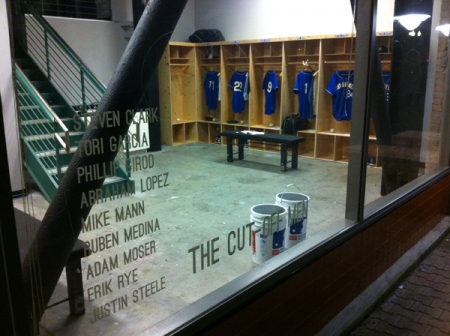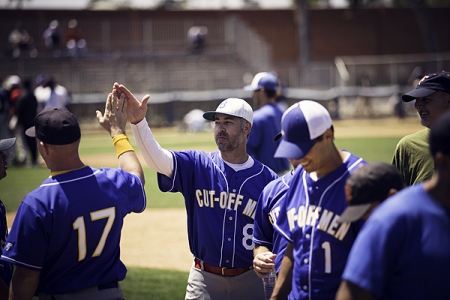OC ART BLOG
Baseball and Art: OC’s two great passions
Posted by Evan Senn on Thursday, June 28, 2012 · Leave a Comment
Santa Ana, CA. Downtown Santa Ana Artist’s Village gets a kick in the contemporary art butt with newest creative addition, Grand Central Art Center’s (GCAC) new Director and Chief Curator, John Spiak. Spiak is a whirlwind of creative energies, and his expertise in Relational Aesthetics and Social Practice are giving the Artist’s Village a transformative new take on the art scene in Orange County. Spiak is bringing in artists from all over the world, to engage and exchange with the Orange County art community. The Artist’s Village in Santa Ana is known for it’s trendy cafes and shops, and it’s heavy artistic flux and flow with galleries and artists around every turn. The caliber of art has been fluctuating between pop-surrealistic paintings and street-art inspired graffiti work for the most part. Spiak’s new twist in programming at the flagship institution of the Artist’s Village, Grand Central Art Center is broadening the community’s artistic point of view, and shedding some well-deserved light on this great art hub.
Grand Central Art Center’s latest Artist-in-Residence, Adam Moser hit it “out of the park” with a collaborative art piece that involved Major League Baseball. Sports don’t traditionally go hand in hand with fine art, but it would seem that Orange County welcomes baseball lovers into the local art scene. (let’s just hope he’s an Angels man). This social practice artist from Portland is realizing his lifelong dream of playing in the big leagues with the help of GCAC, and invited the public to try out with him on his 9-member tryout team, the Cut-Off Men. Moser was the latest addition to the artist-in-residence program at GCAC, but unlike some of the other artists that have come and gone, Moser involves humor, passion, community-oriented teamwork, and the weirdest part–sports into his art practice.
Moser spent many weeks preparing his try out team, and then actually traveling to the try outs in Compton with his Cut-Off Men. The team did not make the league, but the event was spectacular to witness and discuss with artist, Moser and Curator, Spiak. During some reflection time after the tryouts, Adam explained the workings of Social Practice to visitors, the relationships between the teammates and artist, the relationships between the world of baseball and the world of art. This kind of art makes us ask ourselves, “how does this project relate to the workings of Social Practice?”, “What are the relationships between the teammates and artist?”, “Are there really relationships between the world of baseball and the world of art?” It is clear to this writer that asking questions like that is kind-of the point when it comes to this kind of work, and it is this kind of work that is so refreshing to see and experience in the OC. Relevant, insightful, and community-driven artwork. A documentary film was made and screened at GCAC to commemorate the residence and experience.
Grand Central Art Center
125 N. Broadway Santa Ana, CA. 92701
www.grandcentralartcenter.com
Filed under ALL, Art Events, Artist Interviews, Features, Reviews, The Scene · Tagged with Adam Moser, Evan Senn, Grand Central Art Center, John Spiak,MLB, OC Art







